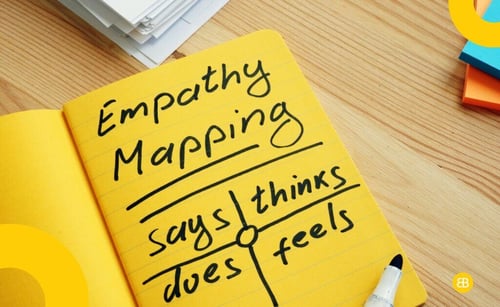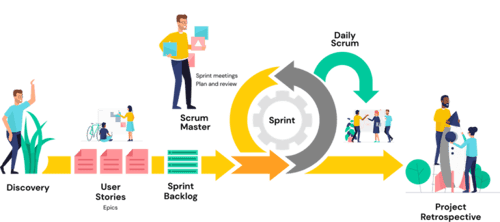Table of Contents
If you're looking to create a mobile app development, you need to read this guide! It covers everything from planning and design to publishing and marketing. With so much information out there, it can be hard to know where to start. But don't worry, we've got you covered. In this guide, we'll walk you through every step of the process so that you can create a successful app without any fuzz, straight-to-the-point. Let's get started!
Who this article is for:
- Startup founders interested in building a successful mobile app
- Product Managers who are looking to build better and more efficient mobile app team
- Anyone trying to minimise the risk associated with their new digital venture
- Anyone looking for new skills in the realms of entrepreneurship and mobile app development
Where to Begin?
Every project begins with an idea based on observations, experience or problems. The journey from idea to a successful mobile application begins with learning as much as possible about the problem you're trying to solve and the potential solutions. This involves researching the relevant field, speaking to domain experts, talking to potential customers, friends, and family and assembling a core team that can help turn your idea into a reality. So let's start with identifying what questions we may need answers for before we get started.
- What problem are we solving with this mobile app? Quick tip. The how Might We method from Google Design sprint may be a good tool to answer this question.
- How can technology enable us to provide better solutions?
- Who are our users? Quick Tip. User personas may be a great way to define your potential customer
- Why will they use our app?
- What do we already know about our users? How can we know more about our users?
- Who are our competitors? How does this mobile app compare to our competition?
- What is the value proposition?
- What would put this app out of business?
- How will we measure success/failure?
- How long will it take to develop the mobile app?
- How much will it cost to develop this app?
- How will we ensure data privacy and security?
Having answers to the above question is a great place to start. However, you may not have answers to all the questions. Reach out to your friends and family, technical experts, and potential users of the application to understand things from their perspective. On top of that, it is a great idea to analyze existing research and information.
Quick tips: Utilise some of these tools to answer the above questions:
- Stakeholder interview: Interview your stakeholders before user research begins to understand things from their perspective. Some questions may be - What is the product? Who will use it? Which customers/users are most important to the business? What challenges do the design team and the business face moving forward? What worries them about this project? Who do they see as your biggest competitor? Why?
- Subject Matter Expert Interview: It is important to involve a subject matter expert to get domain-specific knowledge and understanding of current processes and user journeys. You can ask the following questions - How do things work? How does information flow in the system? What are the most critical factors governing the system? How does it support other systems? Where can things be improved?
Project Vision:
Once you have interviewed your stakeholders and done your research, it is important to map out all the information you have gathered to form a clear vision for the app development. This means understanding what you want your app to achieve and what it will offer users. Once you have a solid understanding of your vision, you can start to put together a team and create a plan of action.
A nice format provided by O'Reilly for product vision statement is outlined below:
We believe that [ doing this / building this feature / creating this experience], For [these people/personas], Will achieve [this outcome], We will know this to be true when we see [this feedback / quantitative measure / qualitative insight.
Discovery
Idea Validation:
After clearly defining the product vision, it is important to validate its potential success. One effective method for validation is to conduct market research through surveys or polls targeting the intended audience. This can provide insight into the level of interest and willingness to purchase the product. Additionally, creating a prototype and gathering feedback from both individuals within your network and potential customers can also serve as validation for the product's viability. Positive feedback from these sources can indicate that the product vision is on the right track.
We have put together a video to help you validate your idea, you can also read more about it in our complete guide to idea validation.

Users
The validation of an idea provides an indication of its potential success, but it is essential to gain a comprehensive understanding of the target customer. Utilising tools such as Persona and customer segmentation can aid in defining and organising customer groups. By gaining a deeper understanding of customer needs and behaviours, one can make a more informed decision on the feasibility and potential success of the product.
User persona
User personas are powerful tools that can help businesses and organisations understand and effectively target their desired audience. By creating a detailed representation of your ideal customer or user, you can gain valuable insights into their needs, behaviours, and goals. This information can be used to inform design, functionality, and growth decisions, and ultimately improve the overall user experience.
Creating a user persona is a collaborative process that involves input from a variety of stakeholders, including product managers, designers, marketers, and customer service representatives. Here is a quick and easy guide to building a user persona:
- Gather data: Collect data on your target audience through surveys, user interviews, and other research methods. Look for patterns and commonalities in the data to identify key characteristics of your ideal user.
- Create a detailed profile: Use the data to create a detailed profile of your user persona, including demographics, behaviours, pain points, and goals. Give your persona a name and a face to make it more relatable.
- Review and refine: Share your persona with your team and gather feedback. Make any necessary revisions to ensure that the persona accurately represents your target audience.
- Use it: Use your user persona as a guide in all decision-making related to your product or service. Keep in mind the needs and desires of your persona when developing new features, designing user interfaces, and crafting marketing messages.
By following this guide, you can create a user persona that provides a clear and accurate representation of your target audience. This valuable tool can help you understand your users' needs and make data-driven decisions that drive business growth and improve the user experience.
A person should include the following items:
- Bio - Name, title, age, and gender
- Roles and tasks - Specific industry, job title/role, typical activities and skills
- Persona class/segment
- Goals - Short term, long term along with work and product-related goals
- Physical, social, and technological environment
Quick Tip. App ideas are plentiful and there's a chance that competitors may have one similar to yours in mind - that's just how creativity can be sometimes. However, when someone outright STEALS your app idea... well then... you've got a problem. What's the best way to protect your app ideas? Watch the video below:

Empathy Mapping
Empathy mapping is a method used to gain a deeper understanding of end users and their attitudes, behaviours, and needs. It involves creating a visual representation of user personas, broken down into four quadrants: "Says" (what the user says or communicates), "Thinks" (what the user is thinking or feeling), "Does" (what the user actually does), and "Feels" (what the user feels or experiences). By understanding and aligning these quadrants through user interviews and research, designers and developers can create more effective and user-centred products.

Customer profile
A customer profile is a crucial tool for businesses to understand their target market's needs and wants. It includes information on customers' "jobs to be done," pain points, and desired benefits. By utilising this information, businesses can effectively tailor their products and services to meet customers' unique needs, improving satisfaction and driving sales.
Competition
Staying ahead in business requires a thorough understanding of your competitors. Through competitor analysis, you can gain valuable insights into a company's strengths and weaknesses, as well as their strategies and market position. This process can help you identify opportunities to differentiate your offerings and develop effective strategies that will give you a competitive advantage. Even though the market is constantly changing, competitor analysis will help you stay up-to-date and ahead of the curve.
Competitor recognition
Conducting a thorough competitor analysis is a vital aspect of maintaining a competitive edge in business. This process involves evaluating both direct and indirect competitors, as well as potential future threats to the market. Direct competitors are those that offer similar products or services within the same industry, while indirect competitors may target the same customer base, but with different offerings. Additionally, it is crucial to consider future threats such as new market entrants that could disrupt the current competitive landscape. To aid in this analysis, various tools such as Google, Google Maps, SpyFu, SimilarWeb, and Searchmetrics can provide valuable insights into a competitor's online presence, market share, and strategies.Google, google maps, spyfu, similarweb, Searchmetrics and others may be a great place to begin.
Porter's 5 Forces Model
Porter's 5 Forces Model is a useful tool for evaluating the competitiveness and attractiveness of a market for potential entrants. The model examines five key factors: the intensity of competition among existing players, the potential for new entrants, the threat of substitute products or services, the bargaining power of buyers, and the bargaining power of suppliers. By identifying and assessing these forces, businesses can gain a deeper understanding of their position within the industry and develop strategies for competing more effectively.
PESTEL Analysis
A PESTEL analysis is a framework used to analyse and keep track of the outside forces that affect an organisation. The outcome of which is used to pinpoint opportunities, threats, and strengths that can be taken into account or employed in a SWOT analysis.
PESTEL is an abbreviation for the several elements that are considered while analysing how the external environment affects a situation. It stands for:
P – Political
E – Economic
S – Social
T – Technological
E – Environmental
L – Legal
- Political factors
These all relate to the manner and extent of government economic intervention. Government policy, political stability or instability in foreign markets, foreign trade policy, tax policy, labor law, environmental law, trade restrictions, and more can all fall under this category. The list above makes it very evident that political factors frequently affect organisations and how they do business.
Organisations must be able to adapt their strategy and policy in response to the existing and projected future legislation.
- Economic factors:
Economic factors have a big influence on how successful an organisation is and how they do business. Economic expansion, interest rates, currency exchange rates, inflation, consumer and business disposable income, and other factors are among them.
Macroeconomic and microeconomic factors can be added to this list of factors. Macroeconomic variables deal with controlling demand in a specific economy. Governments accomplish this primarily through the use of three different mechanisms: interest rate control, taxation, and public spending.
Microeconomic variables mainly concern how people use their earnings.
- Social factors
Social factors deal with people's shared attitudes and beliefs. Population increase, age distribution, health consciousness, career preferences, and other factors are among them. These variables are particularly important since they directly affect how we perceive customers and what motivates them.
- Technological factors
We are all aware of how quickly the technological world is evolving and how this affects how we must conduct business. The way we do business is influenced by a variety of technological elements, including new methods of creating and delivering goods and services as well as connecting with target consumers.
- Environmental factors
Environmental factors have gained more importance as a result of the rising cost of raw materials, government-set pollution targets, the need for businesses to operate ethically and sustainably, and government-set carbon footprint targets (this is an excellent example of a factor that could be classified as both political and environmental at the same time). These are just a few of the difficulties that corporate leaders encounter in this area.
- Legal factors
Health and safety, equal opportunity, advertising standards, laws and consumer rights, product labelling, and product safety are all legal considerations. It is obvious that for businesses to conduct themselves effectively, they must understand what is and is not lawful. Because each country has its own set of laws and regulations, this becomes a particularly difficult area for an organisation to get right if it conducts international business.
SWOT Analysis

SWOT (Strengths, Weaknesses, Opportunities and Threats) analysis SWOT analysis is a method used to evaluate a company's competitive position by identifying its internal strengths and weaknesses as well as external opportunities and threats. This tool enables businesses to understand their competitors' strengths and weaknesses in comparison to their own and to identify potential opportunities and threats in the market. The information gathered through SWOT analysis can be utilised to make informed and strategic decisions, ultimately leading to improved performance and success of the business..
Competitor synthesis is a process that enables businesses to evaluate their competitive position in relation to other competitors in the marketplace. By identifying areas of improvement and opportunities, businesses can optimize their resources and capitalize on available opportunities to increase profitability. Proper competitor synthesis and analysis allow businesses to make data-driven decisions, stay ahead of industry trends and adapt to market changes efficiently. This, in turn, can lead to a stronger and more sustainable competitive advantage in the long-term.

Based on the customer profile, user persona and competitor analysis, it's time to work with all the stakeholders on the value proposition canvas.
Have a look at this excellent video that our team have put together:
Customer Profile
Customer jobs refer to the tasks, problems, or needs that customers are looking to accomplish or solve. Understanding the customer's jobs is important for a company to be able to create products or services that effectively meet the customer's needs and solve their problems.
Gains refer to the benefits or positive outcomes that customers expect or desire from a product or service. Understanding what features customers expect and need, as well as what would delight them, can help a company create a product or service that is more likely to be adopted by the customer. Additionally, understanding what may increase the likelihood of adopting a value proposition can help a company better market and position its offering to the customer.
Pains refer to the negative aspects of the customer experience, such as problems, limitations, negative experiences, and risks that the customer encounters while trying to accomplish their job or meet their needs. Understanding the customer's pains can help a company identify areas where they can improve their product or service, in order to make the customer's experience better and more efficient. It can also help to develop a value proposition that addresses these pains and provides a solution for them. It's important for a company to understand both gains and pains to create a comprehensive customer profile that can be used for product development, marketing, and customer service.

Value Map
Gain creators refer to the specific features or capabilities of a mobile app that provide customer benefits and create customer gains. These can include features that help customers accomplish their jobs more efficiently, solve their problems more effectively, or meet their needs more easily. Gain creators can also include features that offer added value to the customer, such as convenience, personalization, or enhanced user experience. By understanding how a mobile app creates customer gains and offers added value, a company can better design and market its app to meet the needs of its target customers.
Pain relievers would highlight how the product or service provides a solution to the problem that the customer is currently experiencing. It should also address any limitations or risks associated with the use of the product or service and should communicate the benefit the customer will get by using the product or service.
Products and services – the products and services which create gain and relieve pain, and underpin the creation of value for the customer segment.
Value proposition
A value proposition is a clear and concise statement that communicates the unique value and benefit of a product or service to its target customers. This statement serves to differentiate the offering from its competitors and effectively convey the solution it provides to address specific customer needs. A well-crafted value proposition is an essential component of a successful business strategy, as it communicates the unique value that a product or service provides to the target customer and positions the offering as the most viable solution to their problem. It is the foundation of messaging and positioning strategy, and it's crucial for driving sales and driving business growth.
Business Model Canvas
Creating a profitable business is a complex endeavour that requires strategic planning and the implementation of effective tools. One such tool that is highly effective in developing and refining a profitable business model is the Business Model Canvas. This visual chart provides a comprehensive overview of the key components that comprise a business, including the business goals, target customer segments, value proposition, distribution channels, revenue streams, key resources, customer relationships, key activities, and key partners. By utilizing the Business Model Canvas, entrepreneurs and business leaders can gain a deeper understanding of the inner workings of their business, identify opportunities for growth and improvement, and develop a clear and actionable plan for achieving profitability. The Business Model Canvas is a versatile tool that can be used by any type of business, at any stage of its development, and can be adapted to meet the specific needs of the organisation.

By outlining each component of your business model, the Business Model Canvas helps you to identify how value is created and delivered to customers, what resources are necessary for the business to function, and how the money will be made.
Customer Segments
Who are you serving in your business? Who are you helping by creating this app?
Value Proposition
What are you offering your customers with your new app? What does creating an app bring to the table in your business? How can this new app bring value to your customers’ lives?
Channels
How will you connect with your customers?
Customer Relationships
How do you find, get, and keep customers in your business?
Resources
What resources do I need to create an app?
Key Activities
What steps will you need to take to make this new business venture a success? What are the key activities you will need to complete to finish this project?
Key Partners
Partners to help you develop and deliver the mobile app.

Cost structure (Cost of Mobile App Development)
What are our costs and how do we manage funds? What is the cost of Mobile app development?
Revenue Streams
How will we make money? How do we manage revenue?

Some other discovery activities that you may consider are:
User experience design (UX Design)
User experience (UX) design is a critical aspect of app development that focuses on creating solutions that are both useful and enjoyable for users to interact with. The process involves a deep understanding of user behaviour, needs, and motivations through research and testing, which is used to inform the design of intuitive and user-centred solutions.
UX designers work in close collaboration with a variety of stakeholders, including UI developers, product managers, marketers, developers, and other team members, in an iterative process to ensure that designs meet the needs of users while still aligning with business goals. The ultimate goal of UX design is to make app development easy and intuitive for users, allowing them to find what they need quickly and effectively. When executed effectively, UX design can take a good product and make it great by improving the user experience.
UX designers also work closely with app developers to ensure that their designs are technically feasible and aligned with industry standards. This close collaboration aims to create a natural experience for users while still adhering to best practices. Overall, UX design is an essential part of app development that plays a critical role in creating successful and engaging products for users.
Affinity Mapping
An affinity diagram is a powerful tool for organising and consolidating ideas generated during discovery sessions. It is a visual method that groups related information, concepts and ideas in a logical and meaningful way. The objective of an affinity diagram is to identify patterns and relationships among the data, which can lead to the discovery of new and innovative solutions when working through complex problems.
User Journey Mapping
User Journey Mapping and Experience Mapping are powerful techniques used in the design process to gain a deeper understanding of the user's experience. The User Journey Mapping method maps out the user's step-by-step experience as they encounter a problem or interact with a product, providing valuable insight into pain points and opportunities for improvement. Experience Mapping, on the other hand, delves deeper into the user's needs and motivations by understanding their experience within a problem space.
Both methods help teams to gain a deeper understanding of the user's perspective and identify areas for improvement in the user experience. By focusing on how users are interacting with the product, rather than just what they see, teams can gain valuable insights into how to improve product design and functionality. These methods are particularly useful when developing new products or when looking to improve existing products by adding new features that can help users achieve greater results faster. By providing more value to customers, businesses can improve customer satisfaction and increase retention. Overall, User Journey Mapping and Experience Mapping are essential tools for gaining a comprehensive understanding of the user experience, which can help to improve the design and functionality of products and services.
User stories
Once the user journey and affinity mapping have been completed, the next step is to document the user stories to capture the functional requirements. User stories provide a summary of what the user aims to accomplish and the acceptance criteria for completing and accepting the story. Once all the user stories have been defined, we can use various tools such as story mapping and prioritization methods to determine which stories to prioritize. Additionally, user stories can be broken down into smaller, more manageable tasks using techniques such as task breakdown or story splitting. This helps to ensure that the development team has a clear understanding of the requirements and is able to deliver a solution that meets the user's needs effectively. After defining user stories, we can use tools like the Importance/ Difficulty Matrix or the Rose, Thorn, and Bud technique to determine the next set of user stories to be developed.
Wireframing
Wireframing is an important aspect of mobile app design as it offers a clear visual representation of each page within the app. It outlines the page structure, layout, information architecture, user flow, functionality, and intended behaviours. As wireframes typically represent the initial product concept, styling, colour, and graphics are kept to a minimum, allowing the primary focus to be on the overall functionality and usability of the app.
UX designers commonly use wireframing as a practice, as it enables all stakeholders to agree on the placement of information before developers begin to build the interface using code. This approach allows for any potential issues or changes to be identified and addressed early on in the mobile app development process, resulting in a more efficient and cost-effective outcome. Additionally, wireframes provide a shared understanding of the app's design and functionality, aligning all stakeholders' expectations and ensuring that the final product meets the needs of the users.
During Wireframing, it is important to gather feedback from stakeholders and team members to identify potential issues early on and take corrective action as needed, leading not just to better quality products or services but also to increased customer satisfaction for you with your end-users!

Low-fi prototype: Low-fi prototypes are an interactive version of the wireframe and are great to test ideas and usability before investing too much in development, while also evaluating reactions from different design elements at once - improving user experience overall!
Few other activities that you can conduct in the UX stage:
- Present Solution Sketches
- Dot Vote
- Silent Review and Vote
- Decision Matrix
- Heatmap Voting
- Rumble or All-In-One
- Action Planning
- Success Metrics & Signals
- Design Principles
UI Design
UI Design is the process of creating visually appealing, intuitive, and functional visuals for mobile applications that enhance the user experience. It involves designing an interface that is user-friendly, allowing users to easily access and interact with the product. UI Designers use a variety of design elements such as illustrations, icons, logos, and branding to create a cohesive and visually pleasing design.
UI Designers work closely with UX designers to ensure that the visual design complements the overall user experience and meets the needs of the users. They create mockups, and prototypes that can be tested and refined before the final product is developed. UI Designers also consider factors such as typography, colour schemes, and layout to create a consistent and visually pleasing design that is aligned with the brand's identity.

Branding guideline
A brand guideline is a crucial aspect of a business's overall strategy, as it defines the core values, communication style, visual identity, and other elements that collectively create the unique voice and appearance of a brand. By formulating a well-defined brand guideline, companies can ensure consistency across all forms of media and communications, including websites, advertisements, product packaging, and more. It encompasses elements such as the brand's mission and values, logo, typography, colour palette, imagery, and tone of voice. Additionally, it provides guidelines for how the brand should be presented and used in various contexts and across different channels.
User Interface guideline
User Interface (UI) guidelines are an important part of any digital product design. It is a set of rules and standards that describe how the user interacts with the product and aims to ensure consistency and usability across all platforms. UI guidelines should provide details on how to effectively use the product’s features, as well as create a visually appealing experience for users.
Visual design
Once the wireframing has been completed, it is important to reconsider the branding guideline and user interface guidelines. Once you are happy with these guidelines, the first step in the process is to define the visual design direction. The visual design direction should inspire positive emotions in the customer using the mobile app. It should also be aesthetically pleasing, easy to use and visually appealing.
Motion design
Motion Design deals with subtle animations in user interface design that makes the design solution more clear and more enjoyable for the user.
Accessibility
The UI design should consider all the accessibility constraints for wider popular such as colour blindness, vision impairment and others.
Hi-fi Prototype
A High-Fidelity Prototype is a UI design-based representation that closely resembles the final mobile application. It is non-functional in nature but provides a detailed representation of the intended design, layout, and overall user experience. This type of prototype is used to thoroughly examine questions related to usability and to make concrete conclusions about how user behaviour will be reflected in the final product. By creating a high-fidelity prototype, organizations can ensure that the final mobile application meets the needs and expectations of its users.
UX/UI Review: User interface (UI) and user experience (UX) are crucial elements in the development of a mobile app or website. UI design is concerned with the visual design and layout of the app, including the buttons, icons, and other elements that users interact with, while UX design focuses on creating a positive and intuitive experience for users, from the overall flow of the app to how users navigate and interact with its various elements. Both UI and UX play a key role in determining the success of a mobile app or website, as they impact how users perceive and engage with the product.
When reviewing the UI and UX of mobile apps, you should consider the following:
- Is the UI easy to use? Can users intuitively navigate the mobile app?
- Do all elements of the UI look and feel professional?
- Is the UX engaging and interesting? Does it keep users hooked?
- Are there any usability issues that need to be addressed?
Pixel Perfect review: A pixel-perfect review is a detailed examination of the UI design, ensuring every aspect, including the placement and appearance of pixels, is precise. This review process can be applied to a wide range of products with a UI, such as websites, applications, and even hardware. The aim of creating visually appealing and user-friendly designs has been a long-standing challenge in the field of technology. However, with the advancement of graphics techniques and the influence of social media on user behaviour, the bar for designing effective UI has been raised higher. Users now have higher expectations for visually appealing designs and instant gratification, making the design process even more challenging.
Heuristics check: Heuristic evaluations are a practical and cost-effective method for evaluating the usability of a website or application. By comparing the design to established usability guidelines, these evaluations provide valuable insights into the user experience and can help identify areas for improvement. It is crucial to have multiple reviewers to ensure a thorough evaluation and minimize biases. The results of these evaluations can then be used as a starting point for further user testing or improvements.
Iteration: The UX design process is typically characterized by an iterative approach rather than a linear one. UX designers and developers aim to deliver an end product that balances ease of use, error-free performance, and effective creation across various technologies. Despite rapid advancements in technology, this objective remains unchanged even as new technologies emerge.
The idea of iterative development is that it allows designers and developers to take advantage of what's discovered during each cycle, and make necessary modifications to the user interface (UI) or functional capabilities.
Some of the other activities that you can conduct during the UI design phase is
Documentation
- Functional Requirement: A functional requirement is a description of the features and behaviours that a system must possess. User stories are an effective way to capture functional requirements in an agile environment. Each user story should have acceptance criteria defined which determines when the user story is complete and accepted.
- Non-functional Requirements: Non-functional requirements describe properties of a system such as performance, scalability or security that the system must possess. These can be described by metrics or by other means depending on the type of requirement being specified.
- Notification List: In order to ensure that everyone who needs to be made aware of changes to the system is notified, a notification list should be created with contacts for stakeholders, developers, customers, etc. This list should be kept up-to-date based on the changes to the system.
- System Design Model: A system design model is a representation of how a system works and is generally composed of multiple diagrams that display the various components, their interactions and any other relevant information about the system.
Mobile Application Development
The initiation of mobile application development marks an important milestone. The process involves a comprehensive approach that encompasses planning, implementation, and testing of the app. Successful app development demands a deep understanding of the phases of analysis, design, coding, and debugging to achieve a robust solution. To ensure that the final iOS and Android applications meet industry standards and user requirements, it is essential to follow best practices in development, including the use of appropriate tools, technologies, and processes.
Product Backlog
The Product Backlog serves as the comprehensive repository of all requirements and user stories related to app development. This dynamic and prioritized list allows teams to maintain a clear focus on delivering maximum value to customers through a fully functional mobile app. With a well-structured and organized backlog, teams can establish a systematic approach to development cycles, ensuring that resources, timelines, and budgets are effectively managed. This approach offers a flexible framework for adapting to any unforeseen changes or challenges along the way. By having a clear understanding of the work that needs to be done, teams can make informed decisions to keep their projects moving forward and on track towards success.
The Product Backlog plays a crucial role in ensuring the successful development of mobile apps. It provides a comprehensive and organized approach to managing development projects, ultimately leading to the delivery of high-quality products that meet customer needs. By utilizing an iterative and incremental methodology, such as Scrum, teams are empowered to continuously improve their processes and deliver valuable solutions. The Scrum framework consists of a series of sprint cycles that promote adaptive planning, evolutionary development, and early delivery. With a focus on user feedback and continuous improvement, Scrum helps teams achieve success in their projects.

Scrum

During each cycle, team members collaborate to define goals for the upcoming sprint and then work together to accomplish those goals in the allotted time frame. At the end of each sprint, the team reflects on what went well and what could be improved upon in future iterations. This helps ensure that mobile apps features are continually developed and released. The process of the scrum framework are:
- Pre-sprint: The Pre-sprint stage is the first step of Scrum. This is when the team meets to discuss what tasks need to be completed and how they will be accomplished. During this process, roles and responsibilities are defined, deadlines discussed, and any necessary tools or resources for the sprint are identified.
- Sprint Planning: The Sprint Planning meeting is where the mobile app developers further refine their plans for the sprint. The team will discuss what work needs to be done, how it will be broken down into tasks, and who will be responsible for each task.
- Daily Scrum meeting: The Daily Scrum Meeting is a short meeting that happens every day at the same time during the sprint. It is a 15-minute check-in with the app development team, where everyone reviews their progress, talks about any roadblocks they have encountered, and discusses what needs to be done before the end of the day.
- Sprint Review: The Sprint Review is a meeting that takes place at the end of each sprint. During this meeting, the software development team will review their accomplishments from the last sprint and discuss any changes that need to be made for the next sprint.
- Sprint Retrospective: The Sprint Retrospective is a meeting that takes place after the Sprint Review. It gives the development company and software development team an opportunity to discuss what went well and what didn't go so well during the sprint. This meeting helps the team identify areas of improvement and come up with ideas on how to make progress on what didn't go well during the sprint.
An important consideration in Development of Mobile app development
Data privacy
Data privacy is a critical issue for both individuals and organizations. Companies have an obligation to safeguard the personal information of their clients and ensure that it is not misused or disclosed inappropriately. To meet this obligation, companies must adopt and implement a clear and comprehensive Privacy Policy, adhere to industry-standard data storage and security practices, and comply with all applicable regulations. It is imperative that any third-party data processors used by the company are also in compliance with these laws and regulations. Failure to properly protect customer data can result in severe consequences, such as fines, legal action, and a loss of customer confidence. Furthermore, it is essential to regularly review and update Privacy Policies to align with evolving regulations and industry standards. By taking proactive measures to protect customer data, companies can enhance customer trust and avoid the negative consequences associated with data breaches or misuse.
Scalability
In the realm of mobile app development, scalability is a vital consideration. Scalability refers to a system's ability to adapt and expand or contract in response to changes in usage and demands, as well as new requirements that arise over time. Scalable mobile apps offer several benefits, including increased efficiency, improved performance, and reduced costs. Moreover, they provide greater flexibility, allowing the system to evolve and adapt to changing user and business needs over time. By ensuring scalability in mobile app development, developers can create systems that are equipped to meet the demands of a growing user base and changing business requirements.
Security
When it comes to security, there are multiple measures a business must take in order to ensure their systems and data are protected. This includes implementing firewalls, using encryption software, setting up access control policies, and regularly running vulnerability scans.
Seamless experience
A seamless user experience in mobile app development is key to customer satisfaction and loyalty. By designing for intuitive navigation and effortless transitions, companies aim to create a fluid user journey that enhances the user experience and leads to higher satisfaction levels. This, in turn, reduces the need for customer support and increases brand loyalty. A seamless experience is therefore crucial for businesses seeking to engage and retain customers.
Software Version Management
Effective software version management requires a systematic approach to ensure stability and performance. Before making changes, assess the system's performance and consider potential consequences. Keeping multiple versions available facilitates troubleshooting and ensures system operability. Regular performance assessments and a comprehensive approach to version management are essential.
SCM Management with CI/CD
Software configuration management is an approach to bringing control and discipline into the process of creating software. It enhances productivity by boosting application quality while also improving accountability, reproducibility, traceability & coordination. Continuous Integration (CI) and Continuous Delivery/Deployment (CD) are key aspects of successful software development processes. CI/CD enables teams to develop, test, and deploy software faster and with more confidence. By automating the process of integrating code, running tests, building artifacts, and deploying applications, CI/CD helps ensure that mobile app development is of higher quality and that application are released on schedule.

Quality Assurance
Quality Assurance (QA) is a vital aspect of mobile app development that evaluates the app's quality and consistency to meet customer expectations. QA techniques, such as sampling, inspection, and testing, are used to assess app quality. A well-equipped and trained QA department is crucial for any business. The QA team should have knowledge of both the company's products and services and the QA methods used to ensure the quality and customer satisfaction of the mobile app.
Test plan
Test planning is a vital aspect of Quality Assurance (QA). The QA team should create a comprehensive plan that outlines the types of tests to be conducted, the products and services to be evaluated, and the criteria used to determine acceptability. Timing is also a crucial consideration, and the QA plan should reflect the need for testing to be completed efficiently and any issues addressed prior to product release.
In order to effectively plan a QA strategy, QA personnel must have a thorough understanding of the company's testing methods and procedures. This includes knowledge of the products and services to be tested, the types of tests to be performed, and the available time for testing. By developing a well-defined test plan, the QA team can streamline the testing process, improve quality, and ensure the final product meets customer expectations.
Test cases
Test cases are comprehensive documents that outline the expected functionality and performance of a product or service. They are crucial for tracking the results of tests and identifying any issues. There are various types of test cases, including functional, usability, and regression tests, each aimed at assessing different aspects of the product or service. The functional tests examine the features, usability tests evaluate user-friendliness, and regression tests ensure that changes do not cause new problems. Test cases serve as an indispensable tool for both QA personnel and developers, enabling them to verify the correct functioning of their products and continuously improve their quality.
Test Automation
Test automation refers to the utilisation of technology to execute QA processes. Utilizing test automation tools can streamline the testing process, increase efficiency and minimise the risk of human error.
There is a variety of test automation tools available, and it is important for QA professionals to evaluate and select the one that best suits their requirements. These tools can be used to automate tests for web, desktop, and mobile applications, including functional tests, regression tests, user interface testing and backend systems.
Test automation tools play a critical role in a comprehensive QA strategy, enabling QA professionals to automate as many tests as possible, thus speeding up the testing process and reducing the possibility of human error.

Code Quality Review / Code Coverage testing
QA personnel should have a thorough understanding of the company's code quality review and code coverage testing procedures. Code quality review involves examining the code for potential issues such as inadequate design, documentation, and non-compliance with established coding standards. On the other hand, code coverage testing entails the utilization of tools to determine the extent to which the code has been tested. These tools provide valuable insights into the portions of the product or service that have undergone testing and those that remain untested.
By conducting both code quality review and code coverage testing, QA personnel can effectively identify and rectify any shortcomings in the codebase, ultimately ensuring the delivery of high-quality software products.
Unit test
Unit testing is a fundamental component of Quality Assurance in software development, centred around the evaluation of individual units of code. These tests, typically written by developers, serve to verify the functionality and accuracy of their code and provide opportunities for improvement in product quality.
The market offers a wide range of unit testing frameworks, each with its own distinct strengths and limitations. It is imperative for Quality Assurance personnel to familiarize themselves with the available options and select the framework that best suits their specific needs.
Unit tests can be utilized to test both functional and non-functional code and can be performed in isolation or in conjunction with other code components. The consistent application of unit testing greatly contributes to the overall quality and dependability of software products.
Integration test
Integration testing is significant for software quality assurance, aimed at evaluating the compatibility and functionality of different components within a computer system. This process is executed by QA engineers who simulate realistic scenarios to assess the system's performance and behaviour under normal conditions.
There are two common approaches to integration testing, namely "black box" and "white box" testing. Black box testing involves testing the system without any knowledge of its internal structure or code, while white box testing allows for full access to the system's source code, enabling a more comprehensive evaluation of the system's functionality. The goal of both approaches is to identify any errors or potential issues that may arise during use and to ensure the system operates as intended.
Smoke Test
Smoke testing is an initial evaluation of software, designed to confirm the basic functionality and stability of the product. This test is performed at the outset of the development process, and its primary purpose is to identify major defects or issues in the software. The goal of smoke testing is to ensure that the product's critical functions are working as expected before proceeding to more comprehensive testing. This approach provides a quick and efficient means of verifying the viability of the software and helps to minimize the risk of encountering significant problems later in the development process.
Build Verification Test
Build Verification Testing (BVT) is a type of software testing that validates the proper compilation of code and the presence of all required dependencies. It is performed on later versions of the software, after the basic functionality has been confirmed through previous testing. The purpose of BVT is to ensure that the codebase has been assembled correctly, and all necessary components are in place, before proceeding with more extensive testing. By verifying the build, BVT helps to identify issues early in the development process and reduces the risk of encountering problems later.
Functional test:
Functional testing is a crucial aspect of software quality assurance, focused on evaluating the functionality of a program in accordance with its defined requirements. This process is performed to verify that the software's features are functioning correctly, providing an optimal user experience. By conducting functional testing, it is possible to identify any defects or deviations from the desired behavior, thereby reducing the number of issues present in the final product. The goal of functional testing is to deliver a robust and user-friendly software solution that meets the needs and expectations of the end-user.
Regression test:
Regression testing is a software testing method that assesses the impact of changes on a program's behavior. This type of testing is performed to ensure that modifications made to the software do not introduce new errors or negatively affect its functionality. QA professionals use regression tests to evaluate the system's response to changes in its environment or user input, thereby ensuring its continued stability and reliability. Regression tests are designed to detect any unexpected errors that may result from changes to the software, helping to maintain its quality and integrity over time.
User acceptance test:
A user acceptance test, or UAT, is an important part of the quality assurance process. This test is performed by users who are not developers or QA staff, but who represent the target audience for the product. UAT helps to ensure that the product is ready for release and meets the needs of the end user.

Interoperability testing:
Interoperability testing is the process of verifying that two or more systems can exchange information and use it according to specified requirements.
Device compatibility:
When it comes to device compatibility, QA engineers will test how the software application behaves on different types of devices, from desktop computers to smartphones.
Browser Compatibility
Browser compatibility is another critical aspect of QA. QA engineers will test how the software application behaves on different types of browsers, from Chrome to Firefox. They will also ensure that web browsers display the application in an accurate manner. This is especially important for e-commerce websites and other websites that rely on user interaction.
Performance testing
It is a type of QA testing that is used to measure how well a system or component performs under a specific load. This type of testing can help identify potential bottlenecks and help optimize the system or component.
Security testing
It is a key part of QA. Security testing is a critical part of quality assurance. QA teams should work closely with security teams to ensure that all vulnerabilities are discovered and fixed before the product is released. Security testing should be automated wherever possible, and QA teams should be prepared to respond to security incidents quickly and effectively.
Beta release
The beta release is an important stage in the development of a product or service. It provides an opportunity for testing and feedback, and serves as a final opportunity to address any remaining issues before the official launch. The duration of the beta phase varies and is dependent on project complexity. However, it is important to maintain ongoing QA efforts alongside the beta phase to ensure a successful launch.
During this phase, all features should be thoroughly tested and any remaining bugs should be addressed. The beta release is made available to a selected group of users, such as an internal organization or development team, to solicit feedback and refine the product or service. The duration of the beta phase can range from several weeks to several months and is dependent upon the complexity of the project.
It is essential to note that the beta phase should not be viewed as a substitute for ongoing quality assurance (QA) efforts. QA should be continuously carried out throughout the development process to identify and address potential issues. The beta phase serves as a final checkpoint, ensuring that all bugs are fixed and features are as close to the final product as possible.
Continuous bug fixing and rapid delivery
Continuous bug fixing and rapid delivery play a vital role in the beta release process. During this phase, quality assurance efforts must be highly focused on identifying and rectifying bugs in a timely manner. This ensures that the beta release is continually improved and can be made available to the public promptly.
To achieve this, a proactive approach to bug fixing is required, with frequent releases of new versions or updates of the software. This enables users to test the software and provide feedback on the effectiveness of bug fixes. The goal is to maintain a consistent stream of updates that resolve issues as they arise, continuously enhancing the software until it is ready for its official launch.
In summary, continuous bug fixing and rapid delivery are vital components of the beta release process. It necessitates a dedicated and efficient quality assurance team, actively working to identify and resolve bugs and releasing updates with speed and precision. This helps to guarantee that the beta release is as bug-free as possible and that the product or service is prepared for its official launch.
Go-Live setup:
- App Store Submission
- Server setup

Growth, Support and Maintenance
The success of a business is dependent on a well-rounded approach to growth, support, and maintenance. These key components are crucial in driving progress and ensuring the longevity of a business.
Growth focuses on establishing a strong market presence, expanding the customer base, developing innovative products or services, and increasing profitability. This can be achieved through market research, advertising campaigns, customer feedback surveys, and other methods that provide insight into the needs and desires of the target audience.
Customer satisfaction and loyalty are integral to a business, and this is where support comes into play. By offering exceptional customer service and promptly resolving any issues, a positive reputation can be established, fostering customer loyalty and support.
Maintenance is critical to the smooth operation of a business. Regular inspections, repairs, hardware upgrades, software updates, and other tasks help keep all aspects of the business functioning optimally.
In conclusion, growth, support, and maintenance are crucial elements of any successful business strategy. Proper planning and implementation of these components are essential in ensuring the progress and longevity of a business.
Technical debt
Technical debt refers to the extra costs incurred in maintaining and updating existing software code. These mobile app development costs include refactoring, debugging, and other essential tasks required to keep the system up-to-date, secure, and performant. Early recognition and proactive management of technical debt are crucial to prevent the accumulation of substantial debt that can result in increased costs, reduced efficiency, and security vulnerabilities. By taking a proactive approach to technical debt management, organizations can ensure the long-term viability and success of their software systems.
Maintenance
The importance of maintenance cannot be overstated. Neglecting regular care for your application can result in unforeseen failures and challenges, often occurring when it is difficult to determine the root cause of the problem.
Proactive maintenance involves taking necessary steps to ensure the optimal functioning of an IT system, such as updating software components, patching vulnerabilities, monitoring performance metrics, and addressing any technical issues that arise.
In addition, regularly maintaining an IT system helps prevent unscheduled downtime due to technical problems or compatibility issues with other applications. By placing a high priority on maintenance, organizations can ensure the reliable and efficient performance of their IT systems.
Enhancement
The process of enhancing and improving an application requires careful planning, development, testing, and deployment. Effective planning is crucial in ensuring that all aspects of the project receive the necessary attention and resources.
The first step is to identify the desired improvements and features based on customer feedback, usage statistics, and other relevant data. Then, the team should assess the current architecture and any limitations, which will inform the development of a comprehensive implementation plan, including a timeline and budget.
The development stage involves creating, modifying, or extending the code to implement the desired changes. Adequate testing must be performed to confirm proper functionality, using techniques such as unit tests, integration tests, and user acceptance testing.
Before deployment, the application should be released to a staging environment for quality assurance verification. If all is well, the application can then be deployed to production, with appropriate rollback procedures in place to address any unexpected issues.
Brand position, Marketing, and user growth
The brand position of an organization is key to its success and growth. It is essential for companies to define their core values, mission, and strategic objectives in order to create a strong brand that resonates with customers. The best way to grow your business is by creating a strong brand that people can recognize and trust. Marketing strategies like digital marketing, social media campaigns etc., will help you reach out to more customers, so they know about all the great things happening within the company!
In short, defining an effective brand position is essential to achieving user growth. Companies need to communicate their unique value proposition clearly through tailored marketing strategies that reach their target audience.

Other Tools
Tools to utilise to manage and enhance growth:
REAN Template
The REAN (Results, Experience, Adoption, and Net Promoter Score) template provides a comprehensive framework for marketing teams to assess the efficacy of their campaigns and identify opportunities for improvement. By reviewing past projects and evaluating their success, organisations can make informed decisions about future initiatives.
Google HEART model
The Google HEART model offers a user-centric approach to evaluating product experience, by breaking down satisfaction into five distinct categories: Happiness, Engagement, Adoption, Retention, and Task Success. This tool enables product developers to pinpoint areas in need of improvement, such as usability, user experience design, and customer service.
- Happiness - how users feel about the product.
- Engagement - how often they use it.
- Adoption - how many people actually use the product.
- Retention - how often users come back to the product.
- Task Success - how successful users are at accomplishing their desired tasks.
Balanced scorecard
The balanced scorecard is a widely used management tool that evaluates an organisation's performance across four key dimensions:
- Financial stability and growth.
- Customer satisfaction ratings from employee feedback surveys.
- Internal processes include efficiency rates as well as morale among employees who work for this company.
- Learning & growth which assesses how effective they've been at implementing new technologies over time.
By considering all these elements, organizations can gain a well-rounded view of their performance and develop a strategic plan for improvement.
OKR planning template
The OKR (Objectives and Key Results) Planning template provides a systematic methodology for goal setting and performance management. This framework encompasses every stage of the process, including defining objectives, discussing relevant topics, and formulating ideas. The OKR model is an effective means of initiating action towards desired outcomes, as it involves defining clear objectives and determining key results to be achieved in sprints and quarters. By utilizing the OKR Planning template, teams can align their efforts and work towards common goals, resulting in improved efficiency and performance.
Technology roadmap template
A technology roadmap serves as a comprehensive strategic plan that outlines the utilization of technology solutions within an organization's future plans. It provides a clear explanation for the selection and timing of technology solutions and assesses their necessity in relation to the organization's goals. The technology roadmap is designed to facilitate the seamless integration of new systems and processes, maximizing efficiency and minimising waste of resources and time. By creating a technology roadmap, organisations can prioritize their technology investments, align their technology initiatives with their business objectives, and effectively manage technology changes.
A technology roadmap usually includes:
- Company or team goals
- New system capabilities
- Release plans for each tool
- Milestones to reach
- Resources needed
- Training needed
- Risk factors or potential roadblocks to consider
- Status report reviews
DMAIC Analysis Template
The DMAIC (Define, Measure, Analyze, Improve, and Control) Analysis Template provides a comprehensive approach to process improvement in all industries. Rooted in the principles of Six Sigma, this template follows a five-step methodology to achieve cost reduction and an increase in quality in production processes. By utilizing the DMAIC process, organizations can identify and remediate any hindrances to success across departments, leading to substantial improvements in process performance and overall organizational efficacy.
Conclusion
Creating a mobile application for your business can be a manageable task, even for those with limited prior experience. Investing in a mobile app presents a valuable opportunity for businesses to reach their target audience and optimize their success. In the current highly competitive marketplace, it is imperative to continually improve and refine your app to offer increased value to users and remain ahead of the competition.
If you are eager to bring your app idea to fruition, incorporating the best practices discussed above can provide you with a competitive edge and enhance customer satisfaction. Our team of experienced mobile app developers is here to offer comprehensive support, from the conceptualisation stage through to the launch of your app. Let us help you turn your dream into a reality and achieve your business objectives.

As a QA Manager, Yangjee is passionate about quality, automation, and security testing. She thrives on continuous learning to deliver exceptional software.
Read more Articles by this Author
